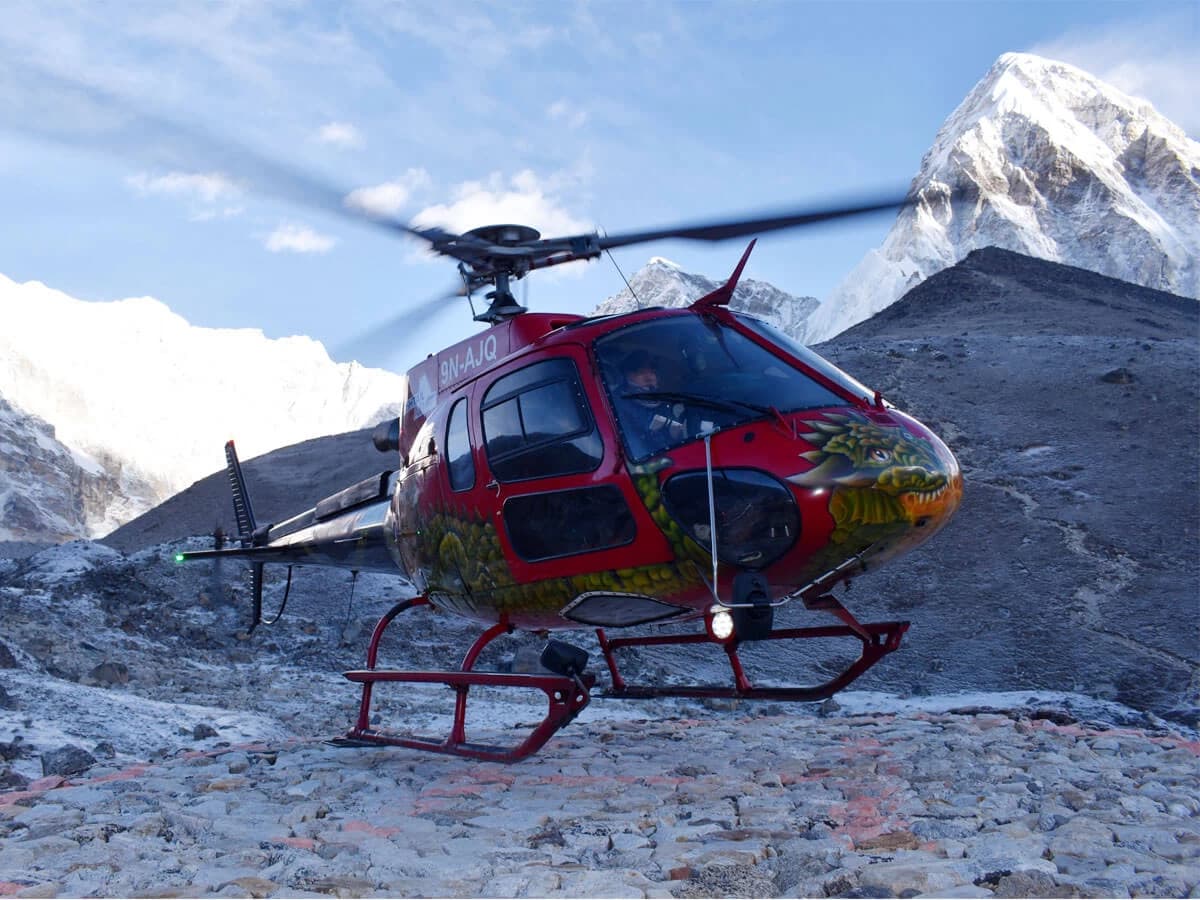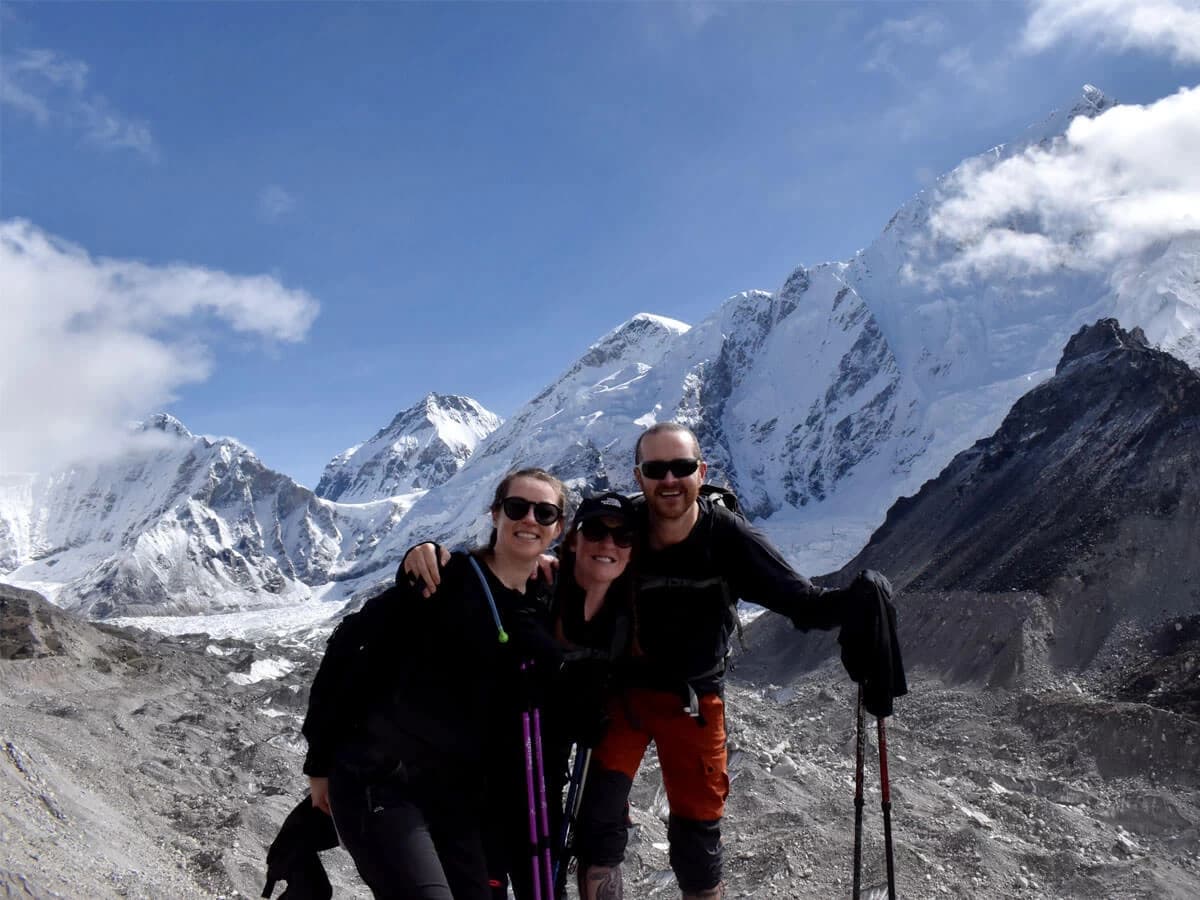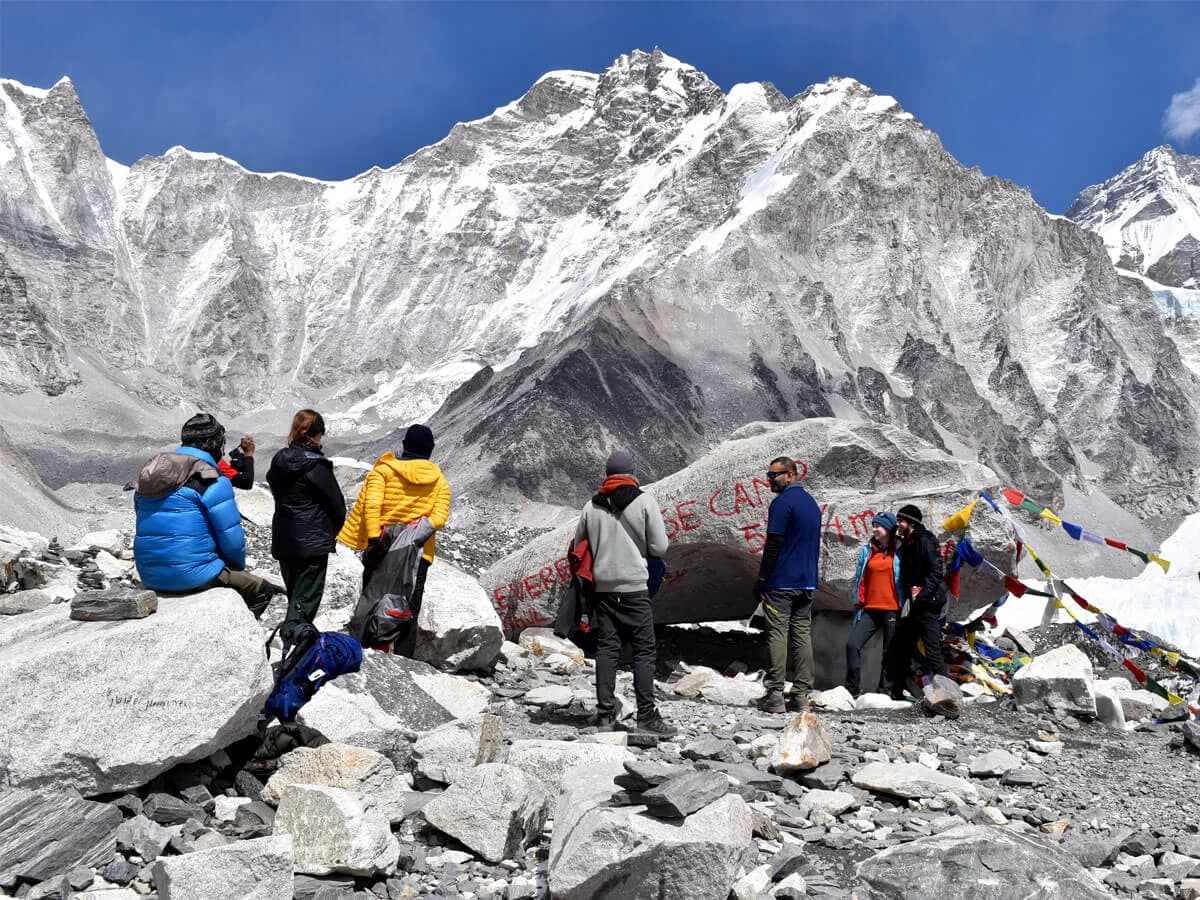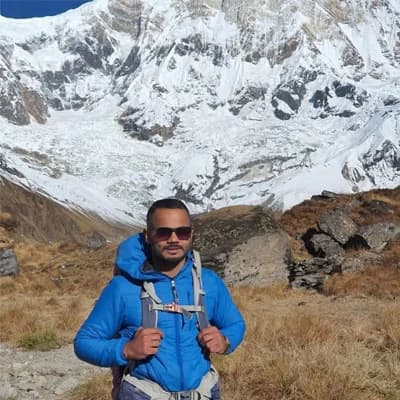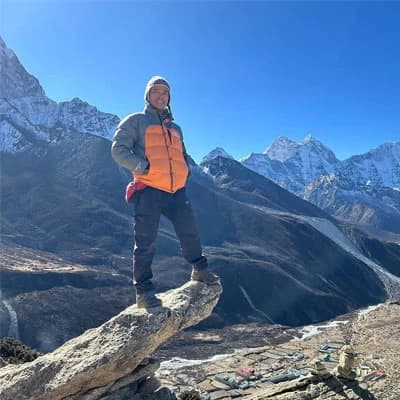Everest Base Camp Trek with Helicopter Return combines the legendary trekking adventure to Everest Base Camp with the ultimate thrill of a helicopter return. The first leg of the journey takes you through the iconic Khumbu region, offering stunning views of Everest, Lhotse, and Ama Dablam, along with the rich Sherpa culture in villages like Namche Bazaar and Tengboche. The second leg, the return flight, offers a rare aerial perspective of the region, combining adventure, spirituality, and luxury for a unique, awe-inspiring experience that leaves you with a deep sense of accomplishment.
Everest Base Camp Trek with Helicopter Return
Everest Base Camp Trek with Helicopter Return is the ultimate way to experience the legendary trails of the Khumbu region while enjoying a swift and comfortable journey back, combining adventure with luxury.
This extraordinary trek takes you through the heart of the Everest region, following in the footsteps of legendary mountaineers. You will trek past iconic Sherpa villages such as Namche Bazaar, Tengboche, and Dingboche, immersing yourself in the rich culture and breathtaking landscapes of the Himalayas. Along the way, you’ll traverse Sagarmatha National Park, a UNESCO World Heritage Site, home to rare wildlife like Himalayan tahrs, musk deer, and the elusive snow leopard.
The adventure reaches its pinnacle at Everest Base Camp (5,364m | 17,598 ft) and Kala Patthar (5,644m | 18,519 ft), where you will witness awe-inspiring views of Everest, Lhotse, Nuptse, and the surrounding peaks. These moments offer a once-in-a-lifetime opportunity to stand at the base of the world’s tallest mountain and admire its grandeur up close.
What sets this journey apart is the thrilling helicopter return from Gorak Shep, which offers a bird’s-eye view of the towering Himalayan giants, deep valleys, and vast glaciers. Instead of retracing the same trekking route, you will enjoy a scenic, time-saving flight back to Lukla or Kathmandu, making this trek ideal for those who seek both adventure and comfort.
The Trek to Everest and Return by Helicopter seamlessly blends high-altitude trekking, cultural exploration, and a luxurious return flight, making it a perfect choice for adventurers looking to experience the best of the Everest region in a limited time.
Highlights
- Begin your adventure with a thrilling flight to Lukla, one of the most scenic and exhilarating air journeys into the heart of the Everest region.
- Trek through legendary Sherpa villages such as Namche Bazaar, Tengboche, and Dingboche, immersing yourself in the rich culture and traditions of the Himalayas.
- Hike through Sagarmatha National Park, a UNESCO World Heritage Site, home to rare wildlife like Himalayan tahrs, musk deer, and snow leopards.
- Stand at Everest Base Camp (5,364m | 17,598 ft), the world’s most iconic trekking destination, and witness the stunning Khumbu Icefall up close.
- Experience a breathtaking sunrise from Kala Patthar (5,644m | 18,519 ft), offering unparalleled panoramic views of Everest, Lhotse, Nuptse, and Ama Dablam.
- Enjoy the best of adventure and comfort with a helicopter return from Gorak Shep, soaring above the towering Himalayan peaks and deep glacial valleys.
- Save several days of trekking with a scenic helicopter flight, providing a bird’s-eye view of the Khumbu Glacier, Gokyo Lakes, and the Everest region.
- Witness historic monasteries like Tengboche, where you can experience the spiritual essence of Tibetan Buddhism against the backdrop of snow-capped peaks.
- Trek alongside seasoned mountaineers and fellow adventurers, gaining insights into the history and challenges of climbing Everest.
- Complete the ultimate Everest Base Camp experience in a limited time without retracing the same route back, making it perfect for those seeking both adventure and convenience.
Everest Base Camp Trek with Helicopter Return Itinerary
Your day starts with an early breakfast before a scenic 30–40-minute flight from Tribhuvan or Ramechhap Airport to Lukla, offering breathtaking views of Everest and the Himalayas.
Upon arrival at Tenzing-Hillary Airport, you will meet your porters and begin a gradual descent along the Dudh Koshi River. After 3–4 hours of trekking, you will reach the serene village of Phakding, where you will settle into a cozy tea house for the night, enjoying a warm meal and the tranquil mountain atmosphere.
After breakfast in Phakding, the trek continues toward Namche Bazaar, the vibrant hub of the Khumbu region. Following the Dudh Koshi River, the trail meanders through lush pine, rhododendron, and magnolia forests, offering scenic beauty along the way.
The route features a mix of gentle ascents and descents, passing through charming villages like Monjo and Jorsale. At Monjo, you officially enter Sagarmatha National Park, a UNESCO-listed site known for its rich biodiversity and cultural heritage.
The final stretch is a challenging uphill climb, but the effort is rewarded with sweeping mountain vistas. On a clear day, you might catch your first glimpses of Everest and Lhotse, making the climb even more rewarding.
Today is a crucial acclimatization day, helping your body adjust to the higher altitude. While rest is important, light hikes are encouraged to enhance the process.
After breakfast, you can take an optional hike to Everest View Hotel (3,962m), where you’ll enjoy stunning mountain views over a warm drink. Another option is trekking to Syangboche Airstrip for panoramic vistas, followed by a descent to Khumjung (3,790m) to visit Khumjung Monastery, home to the legendary Yeti scalp.
In the afternoon, explore Namche Bazaar’s lively markets, cozy cafes, bakeries, and trekking shops. You can also visit the Sherpa Museum to learn about the region’s rich culture and mountaineering history or simply relax at a tea house while soaking in the breathtaking mountain scenery.
After breakfast, the trek to Tengboche follows a scenic, relatively gentle trail, offering stunning views of Everest, Lhotse, Ama Dablam, and Thamserku. The route winds through lush pine and rhododendron forests, passing vibrant Sherpa villages adorned with colorful prayer flags, adding a spiritual touch to the journey.
A gradual descent leads to Phungi Thenga (3,250m), a small riverside settlement along the Dudh Koshi. From here, the trail ascends steeply through dense forests, presenting a challenging yet rewarding climb with ever-expanding mountain views.
Upon reaching Tengboche, visit the famous Tengboche Monastery, witness Buddhist rituals, and soak in breathtaking panoramic vistas. As the day winds down, relax in the serene atmosphere, where the golden hues of sunset illuminate the towering peaks.
The day begins with a descent through lush rhododendron and pine forests, followed by a suspension bridge crossing over the Imja Khola. As the trail ascends, the landscape shifts to an alpine setting with sparse vegetation and rugged terrain.
Passing through Pangboche and Shomare, you will be treated to breathtaking views of Ama Dablam, Lhotse, and Island Peak. Pangboche, the region’s oldest Sherpa village, is known for its traditional stone houses and historic monasteries.
Upon reaching Dingboche, the scenery opens up to vast fields enclosed by stone walls, protecting crops from strong winds. This peaceful village, surrounded by towering peaks like Ama Dablam and Taboche, offers a perfect place to rest, explore, and acclimate to the higher altitude.
Today is an essential acclimatization day to help your body adjust to the altitude. After a relaxed breakfast, you can take an optional hike to Nangkar Tshang (5,083m), which offers panoramic views of Lhotse, Makalu, and Island Peak—a rewarding way to enhance acclimatization while enjoying stunning mountain scenery.
Alternatively, you can explore Dingboche, visit local monasteries, or simply unwind in the tranquil surroundings. Whether hiking or resting, this day is designed to prepare you for the higher-altitude journey ahead, ensuring a smoother and more comfortable ascent.
Leaving the scenic village of Dingboche behind, the trail gradually ascends through windswept landscapes, offering breathtaking views of Taboche, Cholatse, and Ama Dablam. The path becomes more challenging as you make your way toward Thukla, where a steep climb awaits. This ascent, though short, is demanding due to the increasing altitude and rugged terrain.
At Thukla Pass, a solemn yet inspiring site awaits—memorials dedicated to mountaineers who lost their lives in the Himalayas. After taking a moment to pay respects and catch your breath, the trail continues with a steady ascent toward Lobuche, where the terrain becomes rockier, and the air noticeably thinner.
Upon reaching Lobuche, a small settlement nestled beneath the towering peaks, you will settle into a teahouse and rest for the night, preparing for the trek toward Everest Base Camp in the coming days.
Today is one of the most exciting days of the trek as you make your way to Everest Base Camp. After breakfast in Lobuche, the trail ascends gently through rocky terrain, passing the Khumbu Glacier and offering stunning views of the surrounding peaks. The journey is challenging due to the high altitude and rugged path, but the incredible scenery makes every step worth it.
As you approach Gorak Shep (5,140m), the landscape becomes even more barren, with towering glaciers and rocky outcrops. After reaching Gorak Shep, you’ll take a brief rest before continuing on the final leg of the journey to Everest Base Camp (5,364m). The final stretch is a little steeper, but the excitement of reaching Base Camp is palpable.
At Everest Base Camp, you’ll be surrounded by the majestic Khumbu Icefall and towering peaks, offering a sense of awe and accomplishment. Take time to savor the moment, capturing photos and soaking in the breathtaking atmosphere.
After your visit, return to Gorak Shep for the night, where you’ll rest and reflect on the unforgettable achievement of reaching the base of the world’s highest peak.
The day begins with an early start to reach the iconic viewpoint of Kala Patthar (5,644m), one of the best spots for panoramic views of Mount Everest and the surrounding peaks. The ascent to Kala Patthar is steep and challenging, but the reward is unmatched, breathtaking vistas of Everest, Lhotse, Nuptse, and other towering peaks bathed in the soft morning light. Take time to absorb the stunning views and capture this once-in-a-lifetime moment with photos.
From Gorak Shep, you will board a helicopter for a scenic flight back to Kathmandu. As you soar above the mountains, enjoy sweeping views of the Everest region, including the Khumbu Icefall and the surrounding peaks. The flight provides a final, awe-inspiring perspective of the Himalayas, bringing the trek to an unforgettable conclusion.
Upon arrival in Kathmandu, you will be transferred to your hotel, where you can relax and reflect on the incredible adventure you have just experienced.
Everest Base Camp Trek with Helicopter Return Route Map
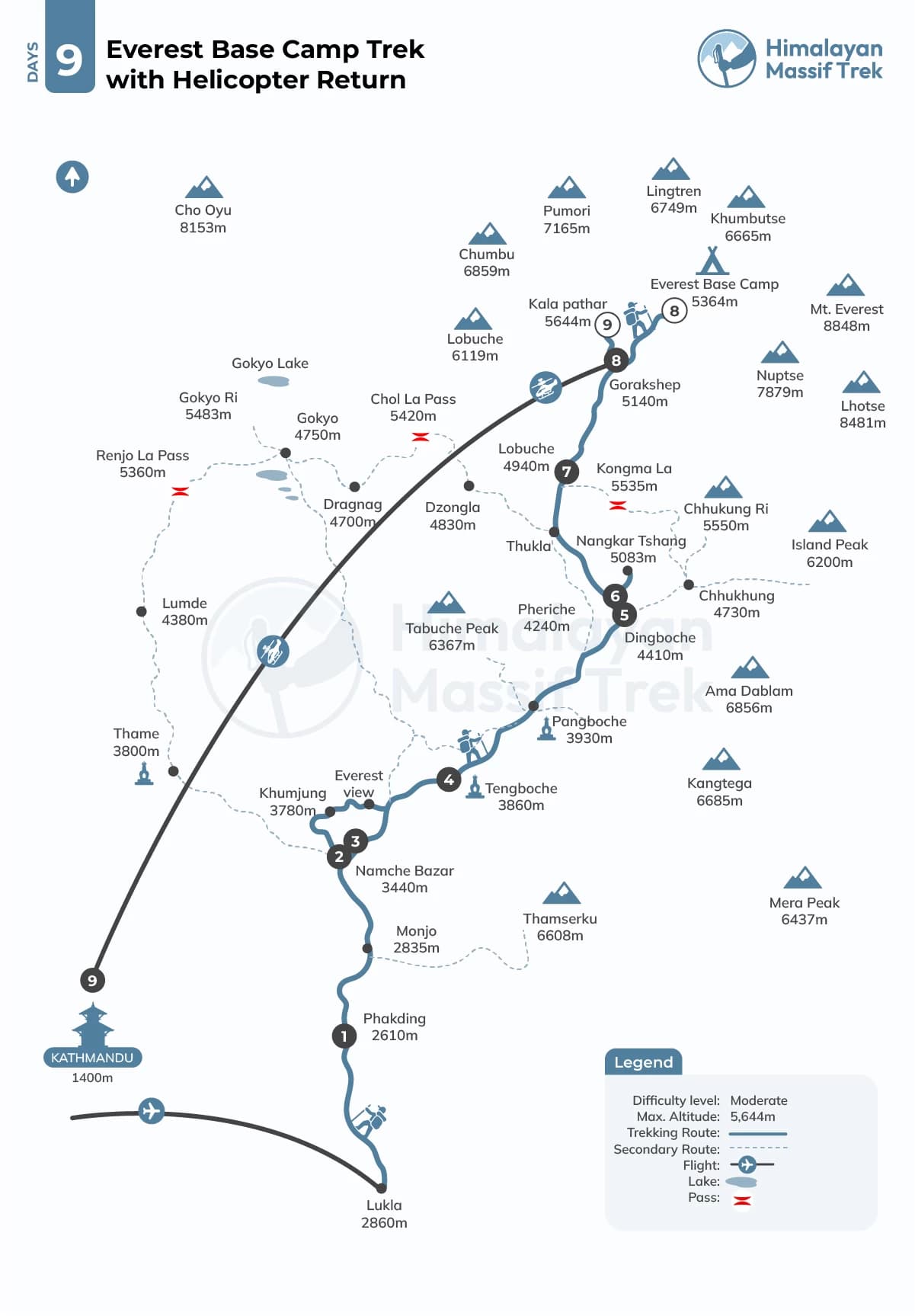

Cost Details
Accommodation:
- 8 nights comfortable lodge during the trek (Attached Bathroom in Namche-2 night, Phakding-1 night, Dingboche- 2 night)
Meals:
- 3 Standard meals a day ( Set of breakfast, Lunch and dinner)
- Farewell dinner in Kathmandu on the last night
Transportation and flights:
- Domestic airport pick up and drop
- Flight to Lukla from Kathmandu or Ramechhap
- Helicopter flight back from Gorakshep to Kathmandu on day 9
- Drop to Ramechhap (during April, May, October and November)
Guide and porters:
- A highly experienced guide and an assistant guide if the group size is bigger than 6 people.
- A strong porter between two trekkers (he carries up to 20kg of baggage)
Permit and document:
- Local government fees
- National park entry permit
Trekking gears:
- Sleeping bag and down jacket to use for the trek
- HMT T-shirt and duffel bag for free
- First aid kit
Miscellaneous:
- Salary, food and accommodation for guide and porters
- Government taxes and liabilities
- International airfare
- Accommodation in Kathmand
- Travel Insurance and Nepal visa fee
- Lunch and dinner in Kathmandu
- Personal expenses include phone bills, cold and alcoholic drinks, laundry bills.
- Personnel trekking gear
- Tipping for trekking guide and porters
To confirm your payment, a deposit payment is required, which is 30% of the total booking price. This deposit helps us secure permits, logistics, and other necessary arrangements for your trek.
We understand that plans can change, and we strive to be as flexible as possible. However, to cover operational costs, a cancellation fee applies. This is a percentage of your total booking price and is deducted from the deposit payment.
Cancellation Fees
Cancel 30% days before departure: 5% of the trip cost
Cancel between 10 to 30 days before departure: 10% of the trip cost
Cancel within 10 days of departure: 20% of the trip cost
If you need to cancel, please notify us as early as possible to reduce charges.
Rescheduling
Unexpected circumstances can disrupt travel plans, even if you still want to do the trip. To support our clients, we have generously waived all rescheduling fees. You can postpone and reschedule your trip at no additional cost, as long as the new departure date falls within one year of your original booking.
Upgrades
If you wish to upgrade your accommodation, transportation, or any other services not mentioned in the Trip Includes section, please be aware that these upgrades will incur additional costs. We can assist in arranging these options for you based on your preferences and availability.
Lukla Plane Flights
Non-Refundable Flight Ticket: If you need helicopter evacuation or other means of transport due to altitude sickness or any other condition, your return flight ticket fare is non-refundable.
Refundable Flight Ticket: If the flight operator cancels your flight due to bad weather in Lukla, Kathmandu, or any other reason, your flight ticket fare is 100% refundable.
Helicopter Flights
Helicopter Return: If you need helicopter evacuation or other means of transport due to altitude sickness or any other condition, your helicopter return flight ticket fare is non-refundable.
Medical Evacuation: Please note that conditional medical evacuation by helicopter is not a part of your return flight. Should you require a medical evacuation, an extra fee for heli transportation will apply. This is covered by the client themselves or their travel insurance provider.
Dates & Availability
Private TripIf you don't find an appropriate date, you can propose a Preferred Departure Date, and we’ll ensure the trip runs as scheduled just for you.
Trip Gallery
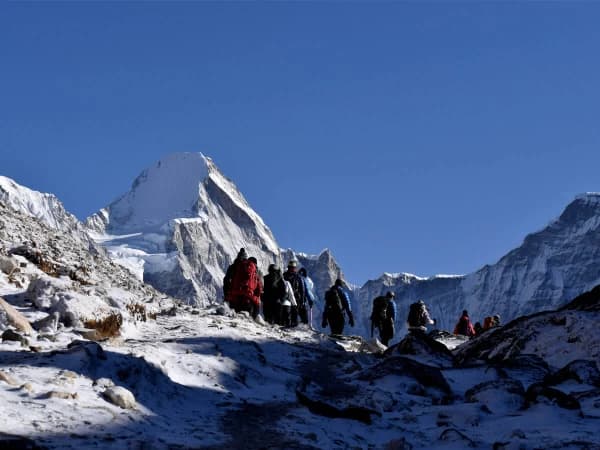
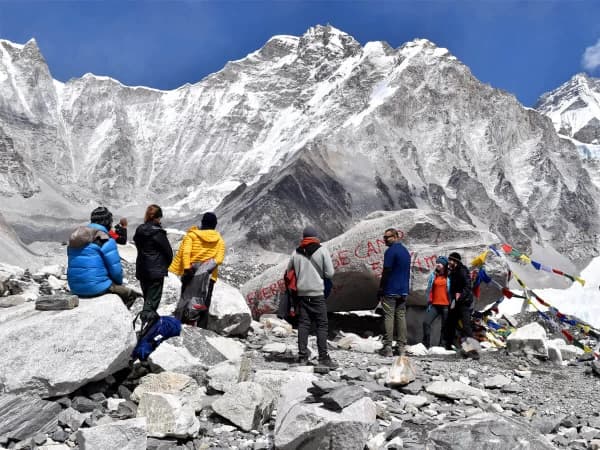
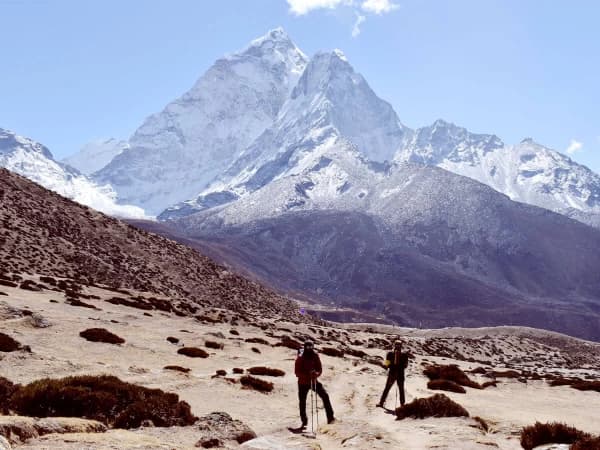
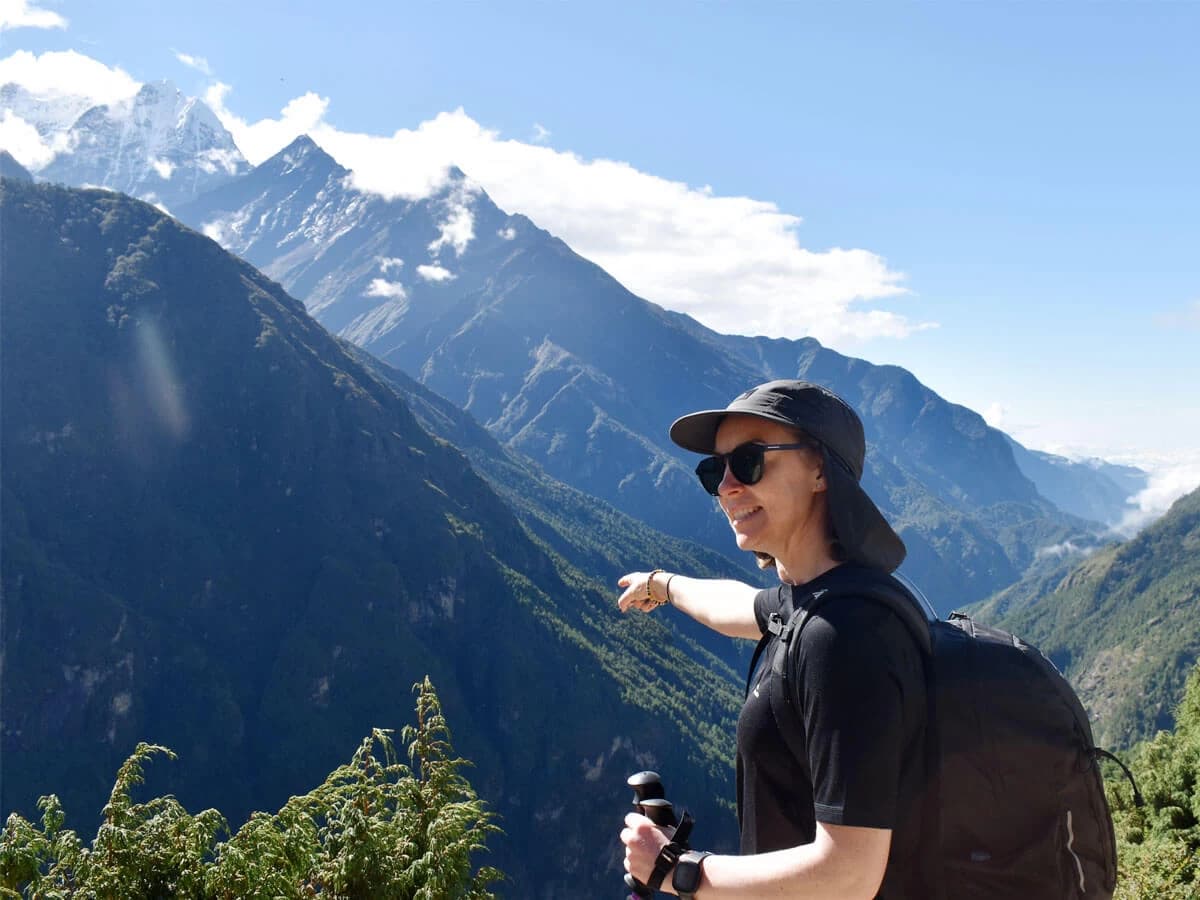
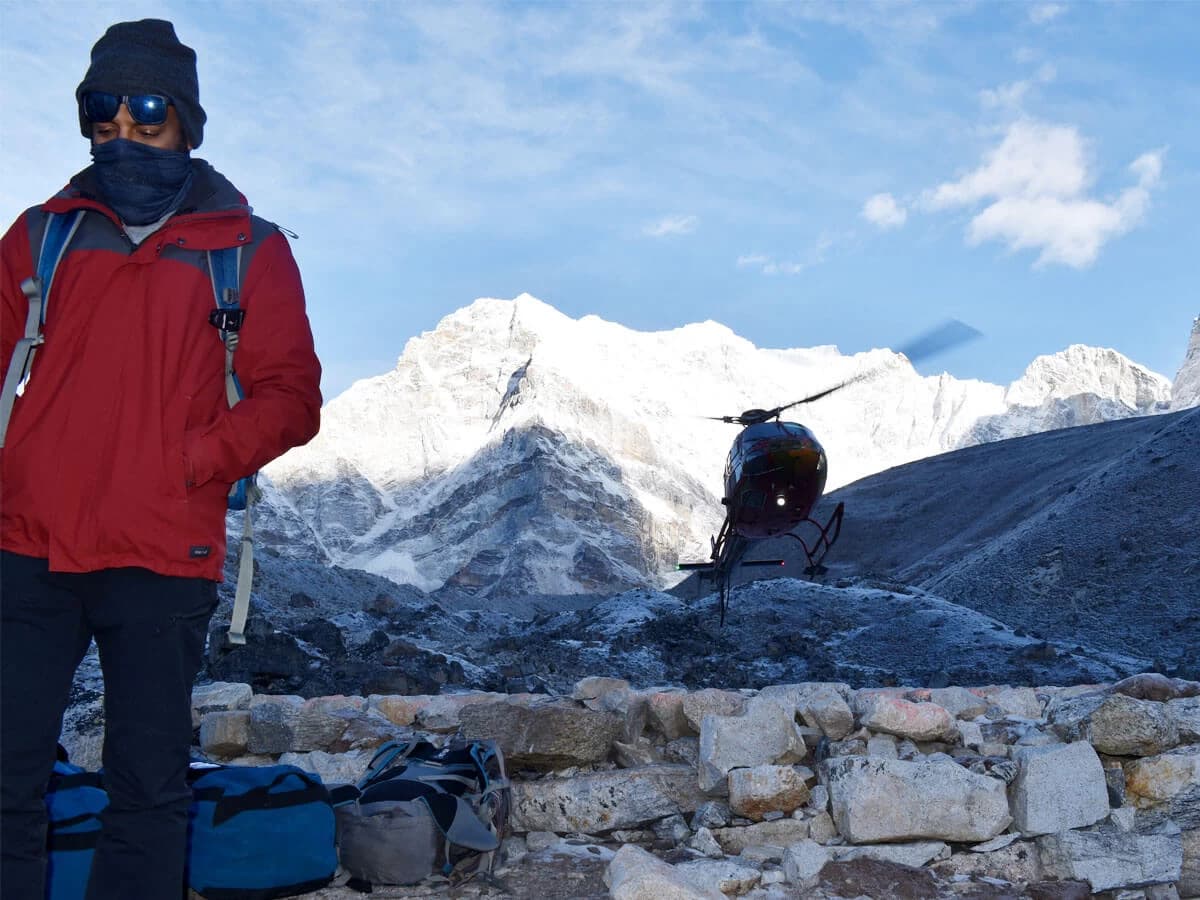
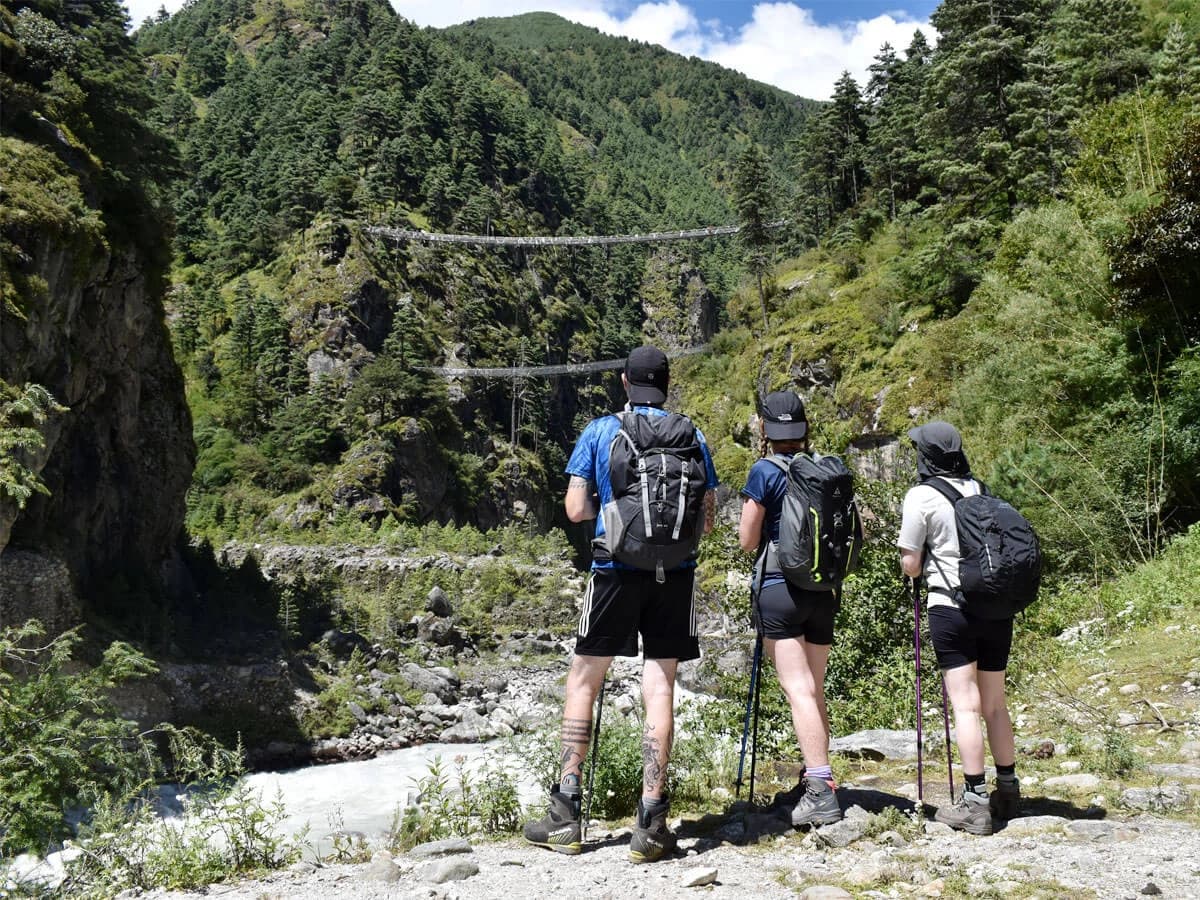
Essential Information
Best Time for the Everest Base Camp Trek with Helicopter Return
Planning the Everest Base Camp Helicopter Return Trek requires precise timing, as it involves both high-altitude trekking and a helicopter flight back to Kathmandu. Unlike standard treks, where you have some flexibility in adjusting your itinerary based on weather and altitude adaptation, the helicopter return adds an extra layer of planning because flight operations depend heavily on weather conditions.
Sudden changes in visibility, wind speeds, and cloud cover can lead to delays or cancellations, making it essential to choose the right season for a smooth experience.
The Himalayan weather is highly unpredictable, even during favorable seasons. Mornings are generally clearer, providing better flight conditions, while afternoons often bring cloud cover and increased wind speeds, which can affect helicopter operations.
This is why most helicopter flights are scheduled in the early morning to ensure safe and stable conditions. However, even during peak trekking seasons, unforeseen weather changes can occur, so it’s wise to have some buffer days in your itinerary in case of delays.
For the best experience, plan your trek during seasons that offer stable weather and clear visibility. While spring (March-May) and autumn (September-November) are the most recommended periods due to their dry conditions and clearer skies, even these months require careful planning.
Winter (December-February) offers stunning, snow-covered landscapes with fewer crowds, but extreme cold and potential snowfall can make the trek more challenging. Monsoon (June-August) is the least ideal time, as heavy rainfall and cloud cover frequently disrupt both trekking and flight schedules.
Permits and Entry Requirements: Essential Documents for EBC Trek and Chopper Return
Himalayan Massif Trek will take care of all mandatory trekking and helicopter permits, allowing you to focus entirely on the experience without worrying about documentation. With everything arranged in advance, you can enjoy a seamless trek and a safe, comfortable helicopter return to Kathmandu.
Sagarmatha National Park Entry Permit
Everest Base Camp lies within Sagarmatha National Park, and all trekkers must obtain this permit to enter the region. It is available in Kathmandu (Nepal Tourism Board Office) or at the park entry gate in Monjo.
Permit Fees:
Foreign Nationals: NPR 3,000 per person
SAARC Nationals: NPR 1,500 per person
Nepali Nationals: NPR 100 per person
(An additional 13% VAT applies to all fees.)
Khumbu Pasang Lhamu Rural Municipality Permit
This permit replaces the TIMS (Trekkers’ Information Management System) Card in the Everest region and is mandatory for all trekkers. Unlike the Sagarmatha National Park Entry Permit, this permit must be obtained in Lukla or Monjo and cannot be acquired in Kathmandu.
Permit Fees:
Foreign Nationals: NPR 2,000 per person
SAARC Nationals: NPR 2,000 per person
Nepali Nationals: Free
Required Documents: Passport details (no physical copy required).
Important Note: This permit is checked at various points along the trail. Trekkers without it may face fines or be denied access to the region.
TIMS (Trekkers’ Information Management System) Card
Helicopter Landing Authorization
Helicopter flights at Everest Base Camp, Gorak Shep, and Kala Patthar require approval from the Civil Aviation Authority of Nepal (CAAN) and the Sagarmatha National Park Office. We handle these permits, but it is advisable to confirm them in advance.
Flight Clearance and Weather Approvals
All helicopter flights must receive clearance from Lukla Air Traffic Control before departure. Weather conditions in the Everest region are highly unpredictable, and sudden changes in wind speed and visibility can lead to delays or cancellations. It is recommended to have buffer days in your itinerary in case your helicopter flight is postponed due to adverse weather.
Weight Limit Regulations
Helicopters operating in the Everest region have strict weight limits, typically 500 kg per flight, including passengers and luggage.
Passengers may need to share flights with others to stay within weight limits.
Large backpacks may not be allowed, and personal luggage should generally be under 10-15 kg per person.
Packing Essentials: What to Bring for the Trek to EBC and Heli Return
When it comes to the helicopter return from Everest Base Camp, it's essential to pack thoughtfully. While your trekking gear is important for the journey to the base camp, the helicopter ride has different requirements due to weight restrictions and the need for comfort and accessibility during the flight. The following guide outlines the specific packing essentials for the helicopter return, ensuring a smooth and stress-free experience.
1. Adhere to Weight Limits for the Helicopter Ride
Helicopters used for the Everest Base Camp return have strict weight limits, typically around 10-15 kg per person for luggage. This weight limit applies to your daypack, which will be the only bag you take onboard. Larger trekking bags will be left behind with your trekking company to be transported by porters. To ensure you comply with the limits, here’s what to pack:
Daypack (10-15 kg max): The size of your daypack is crucial for fitting comfortably into the helicopter cabin. Aim to keep it small and light—think about what you’ll need during the flight and leave the rest behind.
Essential Gear Only: You should only pack items you'll need immediately, such as a camera, phone, water bottle, and any personal medications. Heavy items like extra clothing, sleeping bags, or trekking poles should stay behind.
2. Pack for Comfort During the Flight
The helicopter flight back from Everest Base Camp is an incredible experience, but with limited space, comfort is key. Here’s how you can prepare for a more comfortable journey:
Layered Clothing: While the weather in the mountains can be cold, especially in the morning, you don’t need heavy gear for the helicopter. Wear lightweight but warm layers, such as a down jacket or fleece, and be prepared to adjust based on the temperature.
Keep Essentials Accessible: You’ll need to keep your camera and phone easily accessible for the flight—this is your chance to capture breathtaking aerial views of the Himalayas! Store these in your daypack in an easily reachable compartment.
Hydration and Snacks: Although the helicopter ride is relatively short, carrying a small water bottle and some snacks is a good idea to stay energized.
3. Prepare for Weather and Potential Delays
The weather in the Everest region is notoriously unpredictable, and this can directly impact the helicopter's return. Delays are common due to low visibility, high winds, or other adverse conditions. Here’s what you can do to prepare:
Plan for Delays
It’s a good idea to leave some buffer days in your itinerary. Helicopter flights may be postponed for a few hours or even a day, depending on the weather.
Stay flexible and in regular contact with your trekking company, which will arrange for alternate plans if necessary.
Weather-Resilient Gear
Although the helicopter provides a quick return, wind and cold conditions can be more pronounced at high altitudes. Be sure to wear windproof clothing and pack sunglasses to protect your eyes from the intense sun and wind at higher elevations.
4. Keep Necessary Documents Handy
When you board your helicopter, it’s important to have all the necessary documents easily accessible for inspection. These include:
Permits: Make sure to have your Sagarmatha National Park and Khumbu Pasang Lhamu Rural Municipality permits, as well as any necessary entry documents, in your daypack.
Identification: Carry a copy of your passport and travel insurance details to show upon request. Keep these documents in a secure, but easily accessible location during your helicopter journey.
5. Consider Comfort and Safety for the Flight
The helicopter flight can be an exhilarating experience, but it’s essential to take note of some practical considerations:
Avoid Overpacking: Since the helicopter’s cargo space is limited, overpacking can disrupt your flight. Only bring lightweight items, and keep your baggage as compact as possible.
Seat Distribution: You may need to share the flight with other trekkers, so be prepared for multiple stops or seat-sharing. It’s also advisable to adjust your seatbelt and ensure it’s properly fastened for safety.
For a detailed guide on packing for the Everest Base Camp Trek, including trekking gear, clothing, and other essentials, make sure to check out our dedicated Everest region packing list blog post [here].
Everest Base Camp Trek with Helicopter Return Equipment List
FAQs
Your safety is the top priority. If your health deteriorates during the trek, whether due to altitude sickness or other health concerns, your guide will take immediate action. While they are equipped to provide basic medical care, they may help you descend to a lower altitude or arrange for a helicopter evacuation if necessary.
Yes, there are a few safety measures you should be aware of for the helicopter flight:
Seatbelts: Always fasten your seatbelt during the flight.
Weight Distribution: The helicopter operator will ensure that weight is properly distributed for safety. Follow their instructions regarding seating arrangements.
Follow Instructions: Pay attention to the pilot’s safety briefing and follow their instructions throughout the flight.
Small Electronics: If you’re bringing any electronic devices (e.g., cameras), secure them properly to avoid accidents or distractions during the flight.
The main advantage of a helicopter return is that it saves you from the arduous trek back to Lukla, which can take several days.
Instead of descending on foot, you get to soar over the mountains, taking in breathtaking aerial views of the landscape. It also significantly reduces the risk of fatigue or altitude-related issues that might arise during a long descent.
The helicopter flight from Everest Base Camp to Kathmandu typically takes around 30-40 minutes, depending on weather conditions and the specific route. The flight is quick and efficient, offering an amazing opportunity to see the Himalayan peaks from above as you descend toward the valley.
Yes, you will get to experience stunning views from the helicopter that are as picturesque as what you see during the trek. The aerial perspective allows you to see breathtaking panoramas of the Everest region, including mountains, glaciers, valleys, and the surrounding terrain.
Yes, there is a chance that your helicopter return could be delayed or canceled, mainly due to weather conditions. The weather in the Everest region is unpredictable, and poor visibility, strong winds, or heavy snow can make it unsafe for helicopters to fly.
In such cases, Himalayan Massif Trek will work with helicopter operators to reschedule your flight or help you explore alternate options. We recommend assigning buffer days in your itinerary to account for potential delays.
Typically, you are allowed to carry a maximum of 10-15 kg of luggage for the helicopter flight from Everest Base Camp to Kathmandu. This includes your daypack and any essential items you need for the flight.
The helicopter has strict weight limits, as the combined weight of passengers and luggage cannot exceed a certain threshold. Larger trekking bags should be left behind and will be transported separately by Himalayan Massif Trek.
For the helicopter ride, it's best to wear comfortable, lightweight clothing and bring a light jacket or down jacket, as temperatures can still be chilly at high altitudes, especially in the morning.
However, you don’t need heavy layers, just wear what you have been wearing for the trek but with a focus on warmth for the high-altitude flight.
Yes, you can carry a camera on the helicopter flight and are encouraged to capture the stunning views. However, drones are typically not allowed due to safety concerns and airspace regulations.
The helicopter ride is suitable for everyone, as it requires no physical exertion. However, if you have health concerns or a fear of flying, it's best to consult your doctor beforehand.
In the morning, the weather is generally more stable with clearer skies, calmer winds, and better visibility, making it safer for flying. As the day progresses, the weather in the mountainous regions can become more unpredictable, with cloud cover and stronger winds potentially making flights more challenging.
While seating arrangements on the helicopter are typically based on weight distribution and balance, you may have some flexibility in choosing a seat. If you have a preference for specific views or comfort, let the operator know in advance.
However, the final decision will be made by the pilot based on the total weight and safety considerations.
If you don’t reach Everest Base Camp in time for your scheduled helicopter flight, your return flight will have to be rescheduled. Depending on availability and weather conditions, this could mean waiting a day or two.
Yes, vegan and vegetarian food options are available on the trek to Everest Base Camp. Many teahouses along the route offer vegetarian-friendly meals, including dal Bhat (lentil soup with rice), vegetable momos, and pasta dishes.
Remember to inform us about your dietary restrictions in advance so we can help arrange a suitable meal plan for you.
Gluten-free options are more limited in the Everest region, but you can find some gluten-free alternatives at lower altitudes. Rice, potatoes, and vegetables are common staple foods, but at higher altitudes, the options may become more basic.
Expertise and Local Knowledge
With decades of hands-on experience, our guides possess an intimate understanding of the terrain, the weather, the trails, and most importantly, the people. Our team members have witnessed firsthand how the landscape and seasons change, and they know how to navigate the challenges that come with trekking in this unpredictable environment.
Authentic Local Experiences
As you journey through authentic Sherpa villages like Namche, Tengboche, Dingboche, and Gorak Shep, you’ll not only trek the iconic paths but also gain a deeper understanding of the time-honored traditions, warm hospitality, and rich heritage that have shaped this incredible landscape. Along the way, you will savor traditional Sherpa meals, offering not only a taste of local cuisine but a taste of the Sherpa way of life.
Value for Money
What you see is what you get—no hidden costs, no surprises. Every detail of your trek, from the necessary permits and comfortable, hand-picked accommodations to the nourishing, authentic meals prepared with care, is included in your package. Our goal is to ensure that you receive exceptional service without compromise, so you can focus on enjoying your journey rather than worrying about additional expenses.
Environmental Responsibility
We are deeply committed to ensuring that our treks in the Everest region leave as little impact as possible on the environment. From using eco-friendly trekking practices to minimizing waste, we take every step to preserve the breathtaking beauty of the Himalayas. We work closely with local suppliers who share our commitment to sustainability, ensuring that both the communities and the natural surroundings benefit from tourism. Our responsible approach helps protect not only the pristine landscapes but also the rich biodiversity that thrives here.
- Expertise in High-Altitude Trekking Adventures
- Over 18 Years of Experience in The Himalayas
- Authorized and Reliable Trekking Partner
- Trusted by Thousands of Adventurers Worldwide

I’ve just returned from the most incredible adventure of my life, thanks to Himalayan Massif Trek! I did the Everest Base Camp Trek with a...
I don’t think I can fully put into words how much the Everest Base Camp Trek with Helicopter Return meant to me, but I’ll try!...
